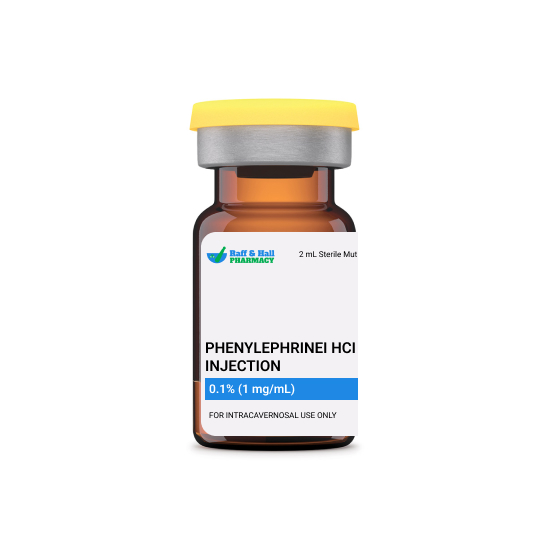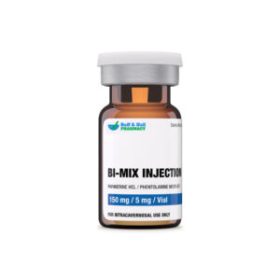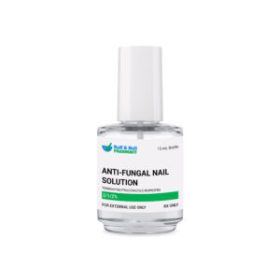This product is available solely through our 503A Compounding Pharmacy, ensuring personalized care and precision in every order. Please note that a valid prescription is required for purchase. If you do not have an account, please contact us.
Phenylephrine HCl Injection (2 mL Vial)
Phenylephrine HCl Injection is a sterile, injectable medication primarily used to increase blood pressure in patients experiencing hypotension, especially during anesthesia. It is a selective alpha-1 adrenergic receptor agonist, which works by constricting blood vessels, thereby elevating systemic vascular resistance and improving blood flow to vital organs. This medication is typically used in emergency settings, operating rooms, or intensive care units.
Phenylephrine exerts its effects by directly stimulating alpha-1 adrenergic receptors on vascular smooth muscle. This activation causes vasoconstriction, which results in increased peripheral vascular resistance and a consequent rise in blood pressure. Unlike some other vasopressors, phenylephrine has minimal effect on beta-adrenergic receptors, meaning it typically does not increase heart rate significantly. Its targeted action makes it useful in managing hypotension without excessive cardiac stimulation.
Phenylephrine HCl Injection is contraindicated in individuals with severe hypertension, ventricular tachycardia, or hypersensitivity to phenylephrine or any component of the formulation. Caution is advised in patients with hyperthyroidism, bradycardia, heart block, or advanced arteriosclerosis, as vasoconstriction may exacerbate these conditions. Close monitoring of blood pressure and cardiac function is essential, especially in patients with cardiovascular disease or during prolonged infusions.
Phenylephrine may interact with monoamine oxidase inhibitors (MAOIs), leading to a hypertensive crisis due to exaggerated vasopressor effects. It can also potentiate the effects of other adrenergic drugs and reduce the efficacy of antihypertensive medications, especially alpha-blockers. Concurrent use with certain anesthetics, particularly halogenated hydrocarbons, may increase the risk of arrhythmias. Always review the patient’s full medication profile before administration.
Possible adverse effects include reflex bradycardia, hypertension, headache, and restlessness. Prolonged use or high doses may lead to reduced cardiac output, arrhythmias, or ischemia. At the injection site, local irritation or tissue necrosis may occur if extravasation takes place. In rare cases, patients may experience anxiety, tremors, or dizziness. Continuous monitoring and prompt adjustment of dose can help minimize these risks.
The safety of phenylephrine in pregnancy has not been fully established. It should be used during pregnancy only if the potential benefits justify the potential risk to the fetus. Phenylephrine can reduce uteroplacental blood flow, which may affect fetal oxygenation. Its presence in breast milk is unknown; therefore, caution is advised when administering to breastfeeding mothers. Consultation with a healthcare provider is essential before use in pregnant or lactating women.
Store this medication at 68°F to 77°F (20°C to 25°C) and away from heat, moisture and light. Keep all medicine out of the reach of children. Throw away any unused medicine after the beyond use date. Do not flush unused medications or pour down a sink or drain.
- Phenylephrine hydrochloride injection package insert. Lake Forest, IL: Hospira, Inc.; 2005 Nov.
- Centers for Disease Control and Prevention (CDC). Infant deaths associated with cough and cold medications – two states, 2005. MMWR Weekly 2007;56:1-4.
- Phenylephrine hydrochloride injection. Eatontown, NJ: West-Ward Pharmaceuticals; 12 Dec.
- Vazculep (phenylephrine) Inj package insert. Chesterfield, Mo: Eclat Pharmaceuticals; 2014 Jun.
- Phenylephrine hydrochloride package insert. Eatontown, NJ: West-ward Pharmaceuticals; 2011 May.
- Smith NT, Corbascio AN. The use and misuse of pressor agents. Anesthesiology 1970;33:58-101.
- Hoffman BB, Lefkowitz RJ. Catecholamines and sympathomimetic drugs. Gilman AG, Rall TW, Nies AS, Taylor P, (eds.) In: Goodman and Gilman’s Pharmacological Basis of Therapeutics. 8th ed., New York, Pergamon Press. 1990. 187—91.
- Cesamet (nabilone) capsule package insert. Somerset, NJ: Meda Pharmaceuticals; 2011 Apr.
- Marinol (dronabinol, THC) package insert. Marietta, GA: Unimed Pharmaceuticals, Inc.; 2003 May.
- Cafcit® (caffeine citrate) package insert. Evansville, IN: Mead Johnson & Company; 2003 May.
- Weinberger M, Bronsky E, Bensch GW, et al. Interaction of ephedrine and theophylline. Clin Pharmacol Ther1975;17:585—92.
- Henman A. Guarana (Paullinia cupana var. sorbilis): ecological and social perspectives on an economic plant of the central Amazon basin. J Ethnopharmacol 1982;6:311—38.
- Boakes AJ, Laurence DR, Teoh PC, et al. Interactions between sympathomimetic amines and antidepressant agents in man. Br Med J 1973;1:311—5.
- Azilect (rasagiline mesylate) tablets. Kansas City, MO: Teva Neurosciences, Inc.; 2014 May.
- Cafergot® (caffeine; ergotamine) package insert. East Hanover, NJ: Novartis Pharmaceuticals Corporation; 2002 June.
- Dexedrine® (dextroamphetamine) package insert. Research Triangle Park, NC; GlaxoSmithKline; 2007 Mar.
- Fastin® (phentermine) package insert. Philadelphia, PA: Beecham Laboratories; 1987 Oct.
- Ergoloid mesylates tablet package insert. Philadelphia, PA: Mutual Pharmaceutical Company, Inc.: 2014 Aug.
- Pitocin® (oxytocin injection, USP) package insert. Rochester, MI: Monarch Pharmaceuticals; 2003 Jan.
- Chua SS, Benrimoj SI. Non-prescription sympathomimetic agents and hypertension. Med Toxicol Adverse Drug Exp 1988;3:387—417.
- Beck RA, Mercado DL, Seguin SM, et al. Cardiovascular effects of pseudoephedrine in medically controlled hypertensive patients. Arch Intern Med 1992;152:1242—5.
- Coates ML, et al. Does pseudoephedrine increase blood pressure in patients with controlled hypertension? J Fam Pract 1995;40:22—6.
- HydroDIURIL® (hydrochlorothiazide) package insert. Whitehouse Station, NJ: Merck & Co., Inc.; 1998 Jun.
- AtroPen® (atropine) injection. Columbia, MD: Meridian Medical Technologies, Inc.; 2003 Jun.
- Elavil® (amitriptyline) package insert. Wilmington, DE: AstraZeneca Pharmaceuticals LP; 2000 Dec.
- amitriptyline hydrochloride package insert. Huntsville, AL: Qualitest Pharmaceuticals; 2010 Apr.
- Ludiomil (maprotiline hydrochloride) package insert. Summit, NJ: Ciba-Geigy Corporation; 1996 Nov.
- Nitro-Dur® (nitroglycerin) package insert. Kenilworth, NJ; Key Pharmaceuticals, Inc.; 2003 August.
- Henderson L, Yue QY, Bergquist C, et al. St John’s wort (Hypericum perforatum): drug interactions and clinical outcomes. Br J Clin Pharmacol 2002;54:349—56.
- Ward PW, Shaneyfelt TM, Roan RM. Acute ischaemic colitis associated with oral phenylephrine decongestant use. BMJ Case Rep. 2014 Jun 3;2014.





